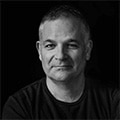Freddy Mamani is a strong believer in the transformative power of the individual imagination. “Human creativity is the deep self-expression of a single being,” he says. “It’s an expression I try to capture in architecture.” It is also an expression he believes can transform the world – just as creativity and drive transformed his life.
Born in a shack in the Bolivian countryside, Mamani is a member of the indigenous Bolivian Aymara community. As a child, he spent two hours everyday walking to school and back. His drive and ambition led him to study civil construction and civil engineering. Eventually he became an architect and made it his life’s work to rescue and re-invent traditional Andean architecture. The result is work imbued with a strong individual vision that’s rooted in his experience as an indigenous person. “My teachers were part of the Andean architecture,” he says. “I believe that what I am doing is the new Andean architecture.”
His signature vision is expressed in cholets, buildings originally found in the Bolivian city of El Alto. The word “cholet” is a portmanteau of the words “chola” (indigenous) and “chalet.” The cholets themselves are full of color, ornate design motifs, and organic shapes. Mamani says they were inspired by the indigenous Andean iconography found in the ruins of Tiwanaku, the capital of a pre-Inca civilization located on the shores of Lake Titicaca.
Mamani sees his work as an open invitation to his country’s young people to join him in the process of re-invention. “We can get to the next level and put the city of El Alto and Bolivia on the map.”
Keep reading
-
Life is a Circus
-
Life is a Circus
-
Life is a Circus
-
Life is a Circus
